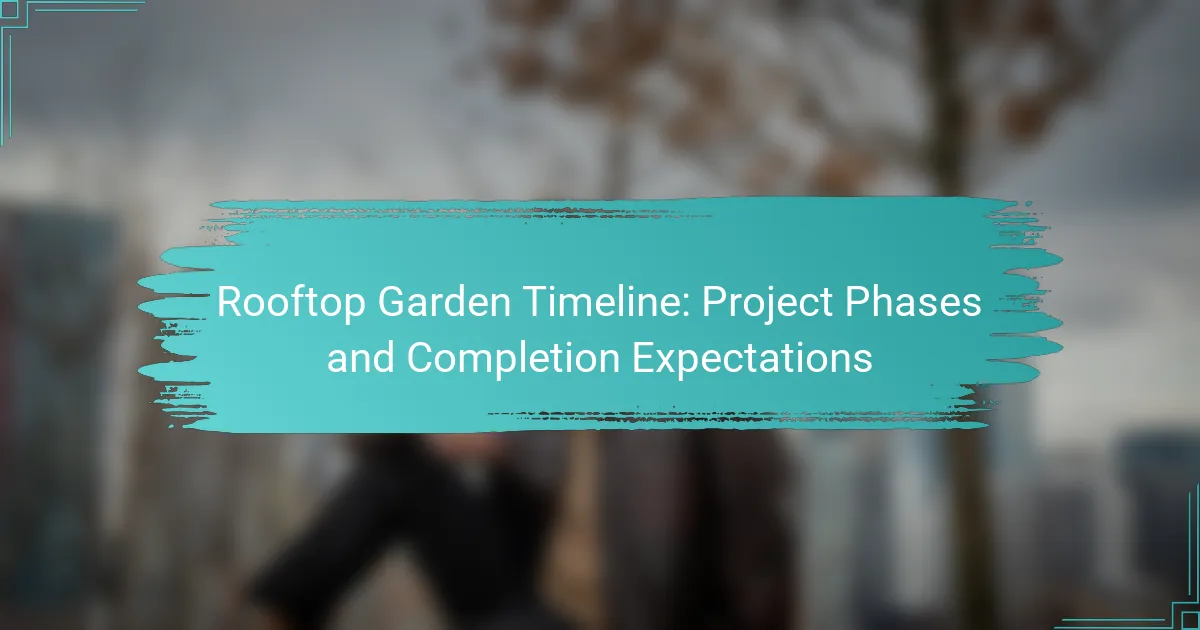Creating a rooftop garden involves a structured timeline that can span from a few weeks to several months, influenced by the project’s complexity and size. The process is divided into three essential phases: planning and design, construction, and planting and installation, each playing a vital role in the garden’s success. Completion expectations vary based on factors such as design approvals and weather conditions, making careful planning crucial for a sustainable outcome.
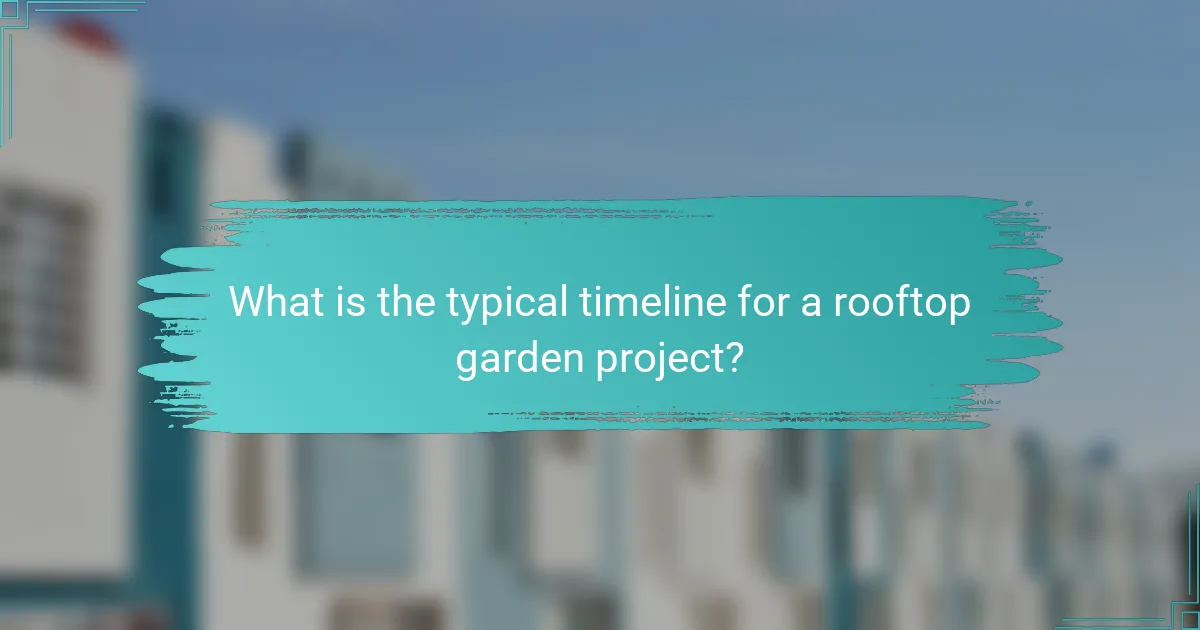
What is the typical timeline for a rooftop garden project?
The typical timeline for a rooftop garden project can range from a few weeks to several months, depending on the project’s complexity and size. Key phases include planning, design, installation, and maintenance, each contributing to the overall duration.
Average project duration
On average, a rooftop garden project may take anywhere from 6 to 12 weeks to complete. Smaller projects, such as container gardens, can be finished in as little as 2 to 4 weeks, while larger, more intricate designs may extend beyond 12 weeks. The timeline often includes time for obtaining necessary permits and approvals.
Factors affecting timeline
Several factors can influence the timeline of a rooftop garden project. These include the size of the space, the complexity of the design, and the availability of materials. Additionally, contractor schedules and weather conditions can cause delays, making it essential to plan for contingencies.
Permitting and zoning regulations may also impact the timeline. In some areas, securing the necessary approvals can take longer than anticipated, so it’s wise to research local regulations early in the planning process.
Seasonal considerations
Seasonal changes can significantly affect the timing of a rooftop garden project. Spring and early summer are typically the best times to start, as they provide optimal growing conditions. However, starting in late summer or fall can also be beneficial for certain plants that thrive in cooler temperatures.
It’s important to consider local climate conditions when planning your project. In regions with harsh winters, construction may need to be paused until spring, while milder climates may allow for year-round work. Always factor in seasonal weather patterns to ensure a successful installation.
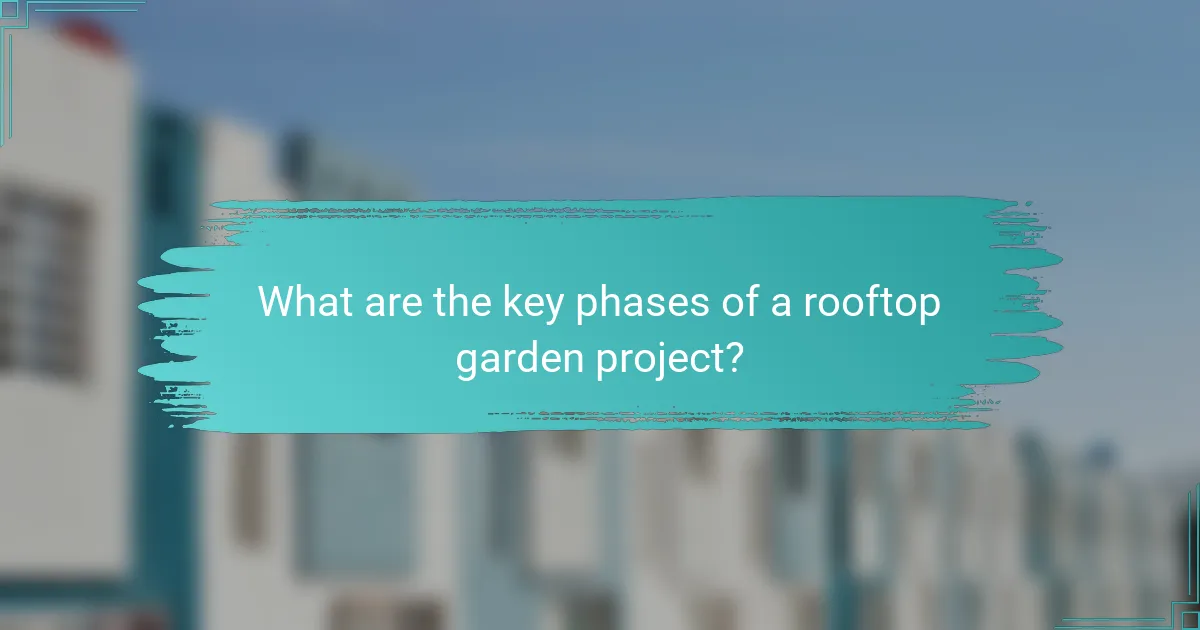
What are the key phases of a rooftop garden project?
A rooftop garden project typically involves three key phases: planning and design, construction, and planting and installation. Each phase is crucial for ensuring a successful and sustainable garden that meets the needs of the space and its users.
Planning and design phase
The planning and design phase is where you establish the vision for your rooftop garden. This includes assessing the structural integrity of the roof, selecting appropriate plants, and designing the layout to maximize space and aesthetics.
Consider factors such as sunlight exposure, wind patterns, and water drainage during this phase. Engaging with a landscape architect or designer can help create a functional and visually appealing garden that adheres to local building codes and regulations.
Construction phase
During the construction phase, the physical elements of the rooftop garden are built. This may involve installing planters, irrigation systems, and any necessary structural supports. It’s essential to use materials that are lightweight and waterproof to prevent damage to the building.
Ensure that the construction adheres to local regulations regarding rooftop modifications. This phase may take several weeks, depending on the complexity of the design and the size of the garden.
Planting and installation phase
The planting and installation phase involves placing the selected plants into the prepared spaces. Choose plants that are suited for the rooftop environment, considering factors like wind resistance and drought tolerance.
It’s advisable to plant during the appropriate season for your region to ensure optimal growth. Regular maintenance, such as watering and pruning, should also be planned to keep the garden healthy and thriving.
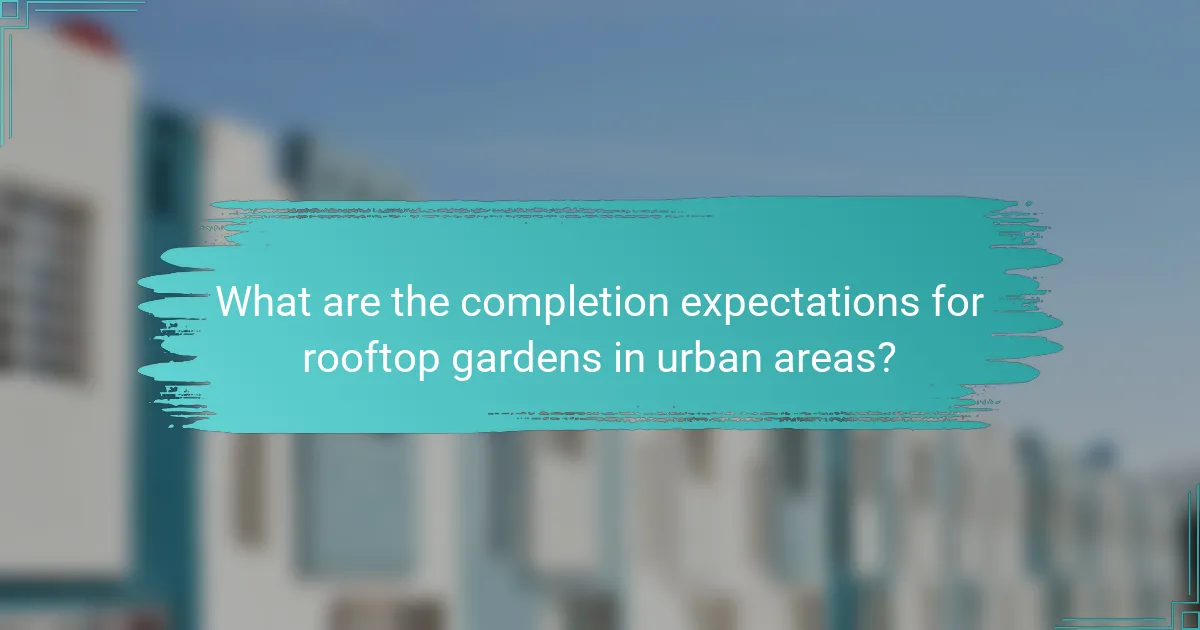
What are the completion expectations for rooftop gardens in urban areas?
Completion expectations for rooftop gardens in urban areas typically involve a timeline of several weeks to a few months, depending on the project’s complexity. Key factors influencing this timeline include design approvals, weather conditions, and the scale of the installation.
Common completion timelines
Rooftop garden projects generally span from 4 to 12 weeks from initial planning to final installation. Simple gardens with minimal landscaping can be completed in the lower end of this range, while more elaborate designs with extensive plantings and features may take longer. Factors such as local regulations and necessary permits can also affect the overall timeline.
It is advisable to factor in additional time for unforeseen delays, such as adverse weather or supply chain issues. Engaging with experienced contractors can help streamline the process and provide more accurate timelines based on specific project details.
Post-installation maintenance
Post-installation maintenance is crucial for the longevity and health of rooftop gardens. Regular tasks include watering, weeding, and monitoring plant health, which can require a few hours each week depending on the garden’s size and plant selection. Establishing a maintenance schedule early on can help ensure the garden thrives.
Consider hiring professional maintenance services if the garden is extensive or if the building’s occupants lack gardening expertise. Additionally, incorporating drought-resistant plants can reduce maintenance needs and water consumption, making the garden more sustainable in urban environments.

What factors influence the timeline of a rooftop garden project in New York City?
The timeline of a rooftop garden project in New York City is influenced by various factors, including local regulations, site-specific challenges, and the complexity of the design. Understanding these elements can help in setting realistic expectations for project completion.
Local regulations and permits
In New York City, rooftop gardens must comply with specific zoning laws and building codes, which can significantly affect the timeline. Obtaining the necessary permits can take several weeks to months, depending on the complexity of the project and the responsiveness of city agencies.
Key permits may include construction permits, environmental reviews, and potentially, special permits if the garden impacts neighboring properties. Engaging with a knowledgeable architect or contractor familiar with local regulations can expedite this process.
Site-specific challenges
Each rooftop presents unique challenges that can influence the project timeline. Factors such as structural integrity, access for construction equipment, and existing rooftop features can complicate installation and require additional planning.
For example, if the roof needs reinforcement to support the garden’s weight, this can add time and cost to the project. Additionally, weather conditions can delay construction; planning for seasonal variations is essential to avoid setbacks.
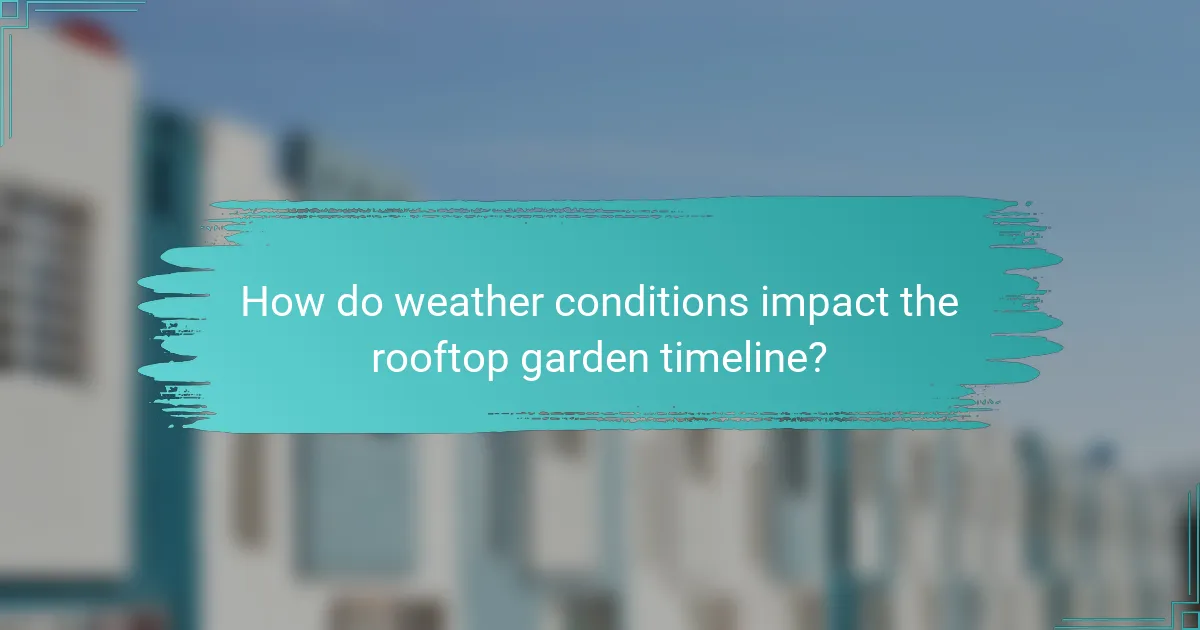
How do weather conditions impact the rooftop garden timeline?
Weather conditions significantly influence the timeline for establishing a rooftop garden, affecting both the planning and execution phases. Factors such as temperature, precipitation, and seasonal changes can delay construction and plant growth, requiring careful consideration during project development.
Impact of seasonal weather
Seasonal weather plays a crucial role in determining the best times for planting and construction. For instance, spring and early summer are typically ideal for planting, while harsh winter conditions can halt progress entirely. Rainy seasons may also lead to delays in construction due to safety concerns and soil saturation.
Temperature extremes can impact plant selection and growth rates. For example, high temperatures can stress plants, while frost can damage young seedlings. Understanding local climate patterns is essential for scheduling tasks effectively and ensuring successful garden establishment.
Mitigation strategies
To mitigate weather-related delays, consider implementing a flexible project timeline that accounts for seasonal variations. Use weather forecasts to plan construction activities and planting schedules, allowing for adjustments as needed. For instance, if heavy rains are predicted, it may be wise to postpone outdoor work.
Additionally, selecting weather-resistant plants can enhance resilience against unpredictable conditions. Utilizing protective measures, such as row covers or shade cloths, can also help safeguard young plants from extreme weather. Regular monitoring and quick responses to changing conditions will support the overall success of the rooftop garden project.
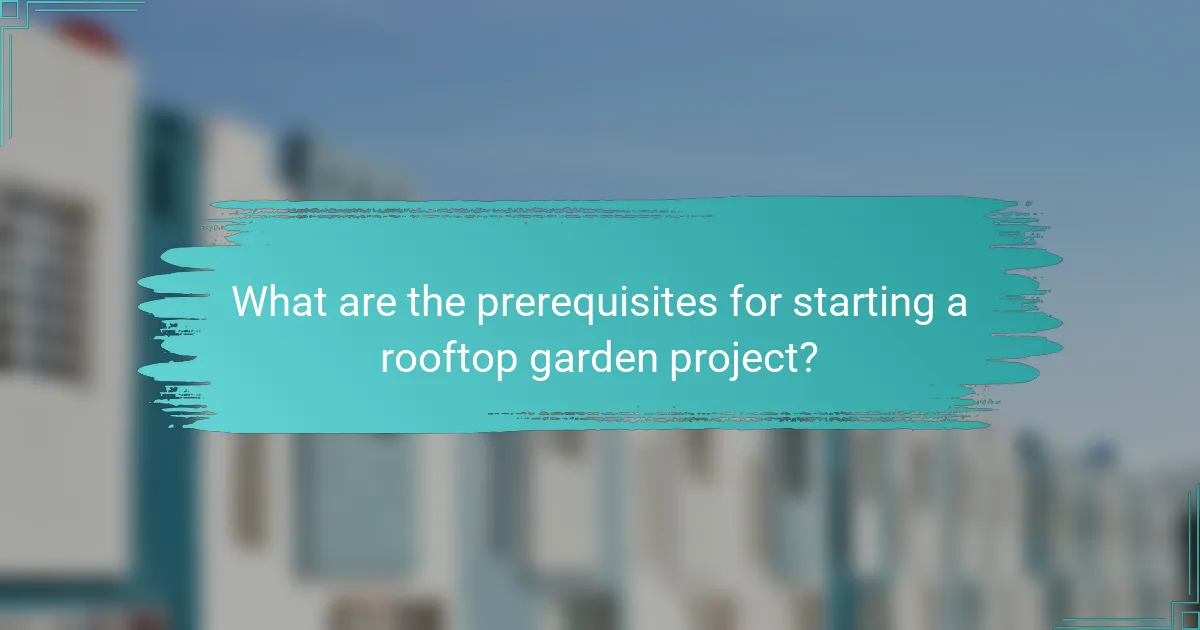
What are the prerequisites for starting a rooftop garden project?
Before starting a rooftop garden project, it’s essential to assess the structural integrity of the building, understand local regulations, and establish a budget. These prerequisites ensure that the garden is feasible, safe, and sustainable.
Site assessment requirements
A thorough site assessment is crucial for determining the suitability of your rooftop for a garden. This includes evaluating the load-bearing capacity of the roof, access to sunlight, and wind exposure. Engaging a structural engineer can help identify any necessary reinforcements.
Additionally, consider the existing drainage system. Proper drainage is vital to prevent water accumulation, which can damage the roof and plants. You may need to install a specialized drainage system if the current setup is inadequate.
Budget considerations
Budgeting for a rooftop garden involves estimating costs for materials, plants, and labor. Depending on the size and complexity, initial setup costs can range from a few hundred to several thousand dollars. It’s wise to allocate funds for ongoing maintenance and potential repairs.
Consider breaking down your budget into categories such as soil, plants, irrigation systems, and structural modifications. This will help you prioritize spending and identify areas where you can save, such as using native plants that require less maintenance.
